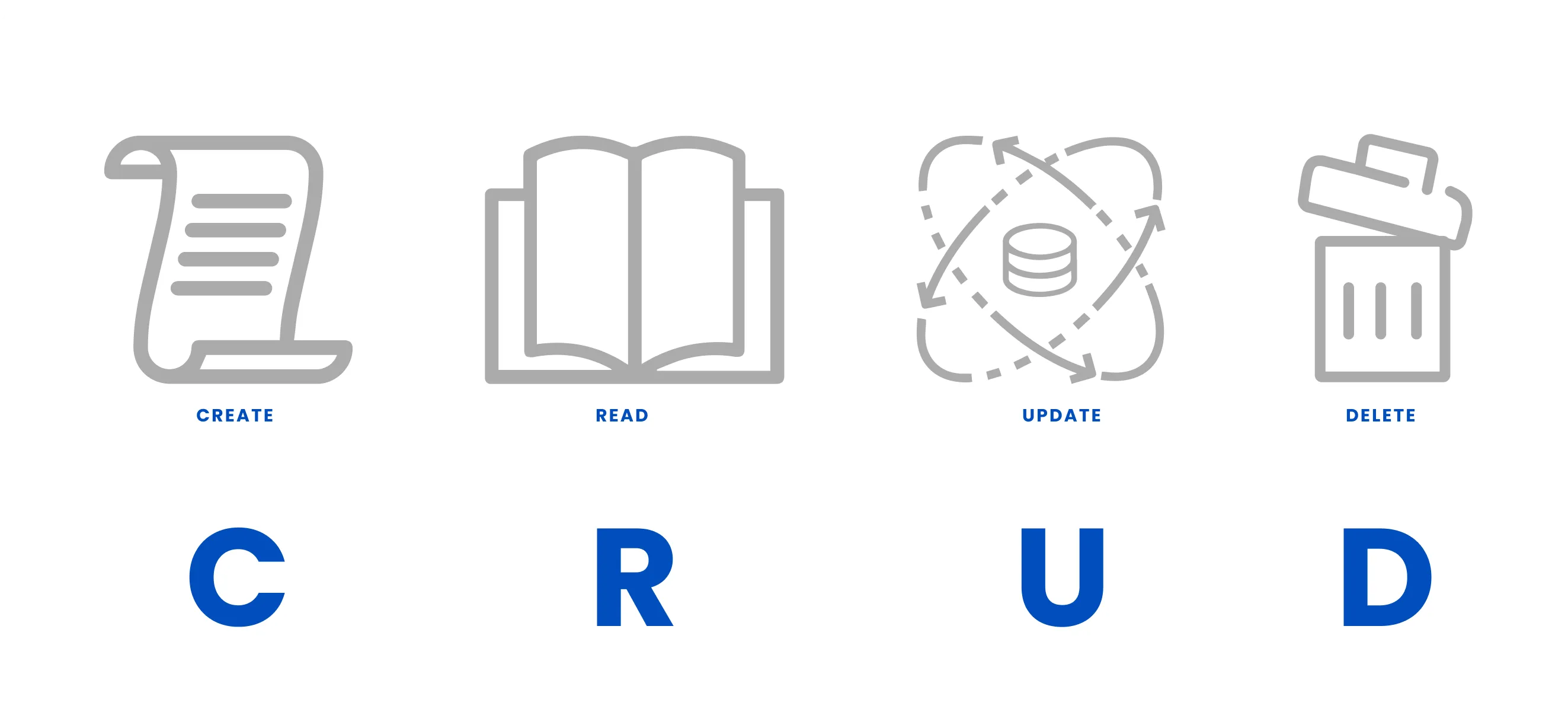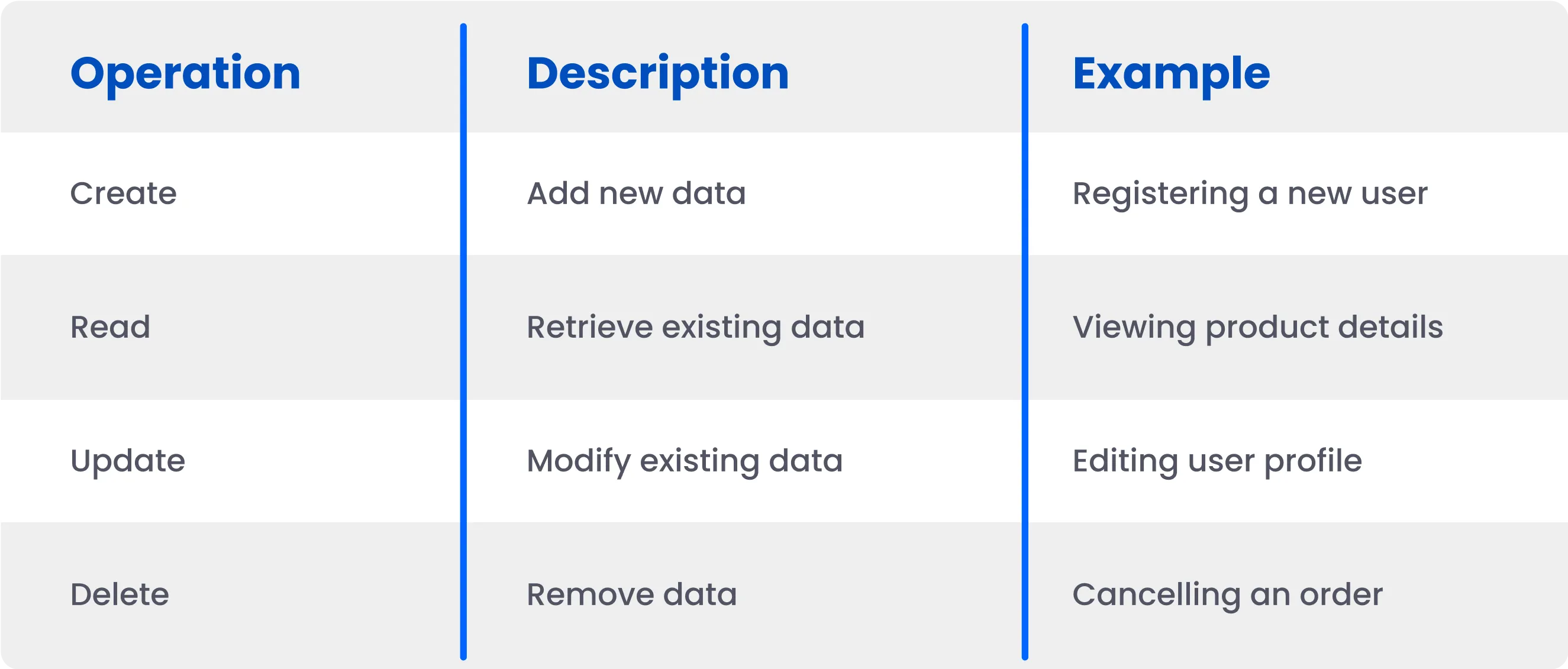Table of Contents
Mastering CRUD Operations: The First Step to Becoming a Developer
Introduction
Every software application, whether a simple web app or a complex enterprise system, revolves around one essential concept — CRUD operations. CRUD stands for Create, Read, Update, and Delete — the basic building blocks that allow applications to interact with data.
Understanding CRUD is the first step in becoming a developer, as it forms the backbone of how applications manage data. Whether you're working on the frontend, backend, or full-stack development, mastering CRUD gives you a comprehensive view of how data flows across an application.
By knowing CRUD operations, a developer will gain an understanding of:
- MVC (Model-View-Controller) Architecture
- REST API and HTTP Methods
- Database Connection and Management
- Data Mapping Between Database and Backend
- Handling Business Logic Through Service Layers
- Repository Patterns for Efficient Data Access
What is MVC & REST API?
MVC controllers handle user requests and interact with the service layer to process business logic, while REST APIs expose endpoints for external systems to perform CRUD operations efficiently. Together, they enable seamless data exchange between the frontend and backend, ensuring a structured and scalable architecture.
MVC controllers handle user requests and interact with the service layer to process business logic, while REST APIs expose endpoints for external systems to perform CRUD operations efficiently. Together, they enable seamless data exchange between the frontend and backend, ensuring a structured and scalable architecture.
Modern applications follow architectural patterns that define how data flows:
MVC (Model-View-Controller): A common design pattern that separates concerns:
- Model: Represents data (e.g., Employee entity)
- View: Displays data (e.g., HTML, React, Angular UI)
- Controller: Handles requests and calls business logic
REST API: APIs expose CRUD operations over HTTP methods:
- POST → Create
- GET → Read
- PUT/PATCH → Update
- DELETE → Delete
As shown in following Figure 1 shows the direct relationship between CRUD operations and the corresponding HTTP methods in a RESTful API. Specifically.

Example API Endpoints:
POST /employees → Create Employee
GET /employees/{id} → Get Employee Details
PUT /employees/{id} → Update Employee
DELETE /employees/{id} → Delete Employee
What is Data?
Before diving into CRUD, it's important to understand what data is in the context of software applications.
Data is any piece of information that applications collect, process, and store. It can be:
- User Information (Name, Email, Password)
- Product Details (Price, Description)
- Transactions (Orders, Payments)
Data is typically stored in databases — structured systems designed to organize and manage information efficiently.
Ways of Data Storage
Relational vs. Non-Relational Databases
- Relational Databases (RDBMS): Store data in tables with predefined relationships. Examples: MySQL, PostgreSQL, Oracle.
- Non-Relational Databases (NoSQL): Store data in flexible formats like JSON, key-value pairs, or documents. Examples: MongoDB, Redis, Cassandra.
Understanding the type of database helps developers choose the right storage model for their applications.
How Data is Stored in Tables
When using a relational database like MySQL, data is stored in tables with columns and rows. Each row represents a record, and each column defines a property of that record.
Example Employee Table:
| ID | Name | Email |
|---|---------|-------------------|
| 1 | Alice | alice@mail.com |
| 2 | Bob | bob@mail.com |
What is CRUD?
CRUD represents the four fundamental operations that can be performed on data:
As shown in following Figure 2 emphasizes the four basic data operations in any software application. Whether you’re storing user information, processing orders, or managing product details, these core operations—Create, Read, Update, and Delete—are essential for data management across various technology stacks.


These operations apply to any kind of data interaction, whether in databases, APIs, or file systems.
Why is CRUD Important?
CRUD operations are essential because they touch every layer of an application:
- Backend Developers: Design APIs to perform CRUD operations.
- Frontend Developers: Call APIs to display and manipulate data.
- Database Administrators: Optimize CRUD queries for performance.
- Full-Stack Developers: Implement CRUD from database to frontend.
Service Layer & Repository
- Service Layer: Centralizes business logic to separate it from controllers.
- Repository: Manages database interactions using Spring Data JPA.
Database Connection in Java
In Java, database connections are handled using JPA, Hibernate, and JDBC. Spring Boot simplifies database connectivity with Spring Data JPA.
CRUD Example in Java
Note: The example language used here is Java to demonstrate CRUD operations.
Let's implement a simple Employee Management API using Spring Boot.
Model Class
@Entity @Data public class Employee { @Id @GeneratedValue(strategy = GenerationType.IDENTITY) private Long id; private String name; private String email; }
Repository
public interface EmployeeRepository extends JpaRepository
Service Layer
@Service @RequiredArgsConstructor public class EmployeeService { private final EmployeeRepository repository;
public Employee create(Employee employee) { return repository.save(employee); } public List
Controller
@RestController @RequestMapping("/employees") @RequiredArgsConstructor public class EmployeeController { private final EmployeeService service;
@PostMapping public ResponseEntity
Conclusion
CRUD operations are more than just simple database queries — they form the core foundation of every software application. By mastering CRUD, beginners gain a deeper understanding of how applications interact with data across different layers. Whether you're a backend, frontend, or full-stack developer, understanding CRUD will set you on the path to becoming a proficient developer.
Start small, practice often, and build your first CRUD-based project today!
Read More

By Prasanth Kumar Ranga
Technical Lead - JAVA
Read other blogs
Your go-to resource for IT knowledge. Explore our blog for practical advice and industry updates.
Discover valuable insights and expert advice.
Uncover valuable insights and stay ahead of the curve by subscribing to our newsletter.

Download Our Latest Industry Report
To know more insights!























